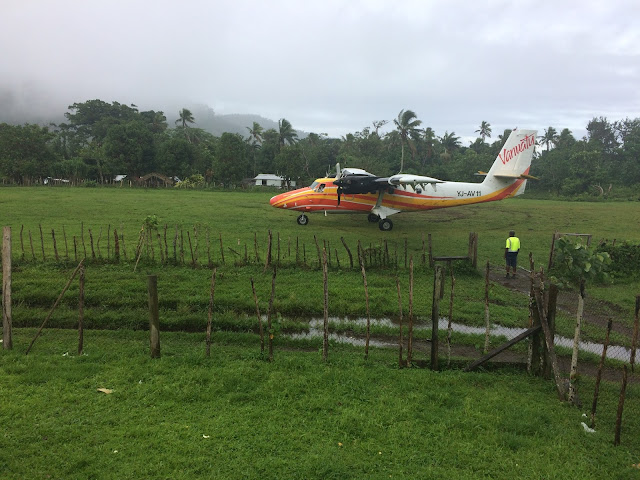Supposedly I'm leaving in a few days for site. I'll be there for 3 months before coming back to Vila again. I say supposedly because logistics are hard to plan here. Many other volunteers were supposed to have left by now, but for one reason or another, haven't. For example, one of the airlines went out of business. Or, a destination airstrip may be too wet for the plane to land, or someone didn't mow the grass.
 |
| The Tongoa airstrip. Cattle graze on it whenever planes aren't scheduled to land. Too much rain makes the ground too soft for landing, and low clouds mean the plane just turns around and will try again another day. |
I'm pretty much all packed up. I thought I'd share what the bags look like, and what's in them. I don't have pictures of everything, but most of it is pictured. I thought this would be interesting to look back on, and might help the next person going to site.
 |
This large bag is called a Chinese Bag, a strong-enough and waterproof-enough bag for moving stuff around in Vanuatu. The bags are very large and great for carrying bulky items like large bowls, buckets and a dish rack. And it reads "Happy Time" on it and is covered with bunnies.
|
 |
| The lid on this barrel forms a tight seal, making it suitable for storing food items like flour and sugar for shipping. It also will keep the rats out on site. This barrel cost 3,500vt. |
 |
| Large, sturdy bins with a latching lid are also good for keeping the rats out. |
 |
| So I bought two. |
 |
| Another Chinese bag. This one was given to us by the Peace Corps. |
 |
| My mattress, and inside and sticking out, my speargun. Every man on Tongariki has a speargun. The two are wrapped in plastic material, which is sold by the meter at many stores for use as tablecloth. |
 |
| A bucket, and inside the bucket is a bucket of "breakfast crackers," which I'm not particularly crazy about, but which will provide another bucket with a tightly-closing lid. |
 |
| The last Chinese bag. I tried to pick the ones with the most ridiculous and cheerful designs. |
 |
| Food, including ingredients to make bread, rice, and others. Milo is hot chocolate btw. This isn't 3 months of food, but food to supplement what is there. With any luck I won't use much of it. |
 |
| Austin's hoist mom made a fire like this for baking bread. After the fire got hot, the rocks would be placed on and around the covered sauce pan to evenly bake the bread. The rocks get hot enough to burn the bread, so you have to keep an eye on it. |
 |
| No refrigeration is available, hence the milk powder. The 3-in-1 coffee mix is coffee+milk+sugar. |
 |
| The large teapot is for heating up water for a bath, the smaller for daily use. The two large sauce pans are called sauce pans, or coquettes here. They're cast aluminum and what everyone uses. |
 |
| Two pans for dishes, one for soaking/washing and the other for rinsing. And I got a funnel just because. |
 |
| Place mats, seeds for some vegetables, laundry detergent, and white vinegar. Blue tack is a putty everyone uses to hang up papers, etc. It is used in classrooms. The dark thing above it and the vinegar is a small pump for inflating soccer balls. Candles next to the seeds, and on top is a pair of place mats. |
 |
| Peanuts. I'll be planting some too, using peanuts I'll buy from the local market. Many natives here grow peanuts. |
 |
| A couple of receipts from the Au Bon Marche. There are several of this grocery store chain in Vila. 100 Vatu=$1. So, the Colgate at 590 vt=$5.90. "Tusker 330ML Lemon" is the local beer. |
 |
| This is for a 60W solar system for my site, which includes a 60W panel, 40Ah battery, regulator, and six lights. ($360). I learned that all of the solar stores only take cash. Most of the stores here only take cash, Au Bon Marche being an exception, but given the high dollar purchases for solar setups, I was surprised I had to pay in cash. Maybe they do not move enough volume to justify the overhead of taking plastic? |
 |
| Here's the speargun. |





















Comments
Post a Comment